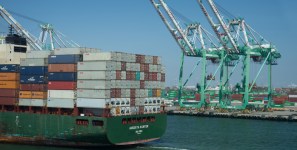Cashing in on Climate Change
In December, kids envision Santa Claus loading his sleigh at the North Pole, ready to deliver toys on Christmas Eve.
This year, and in years to come, he may notice some extra traffic in the Arctic, as more countries and companies utilize the ultimate northern shipping route.
It was a trend that first peaked back in 2013, when more than 70 ships sailed through the Northeast Passage across the top of Russia and Siberia. One of the route’s greatest appeals is that it takes about 10 to 14 fewer days to get from Asia to Europe this way than through the Panama Canal or the Suez Canal.
But that number quickly declined to just 18 vessels in 2015 due to lower oil prices and higher insurance costs. The closing of Canada’s only Arctic port also made sailing near the top of the world less advantageous.
However, judging from preparations now underway in Russia, China, Canada, and the United States, business is about to pick up once again.
Two months ago, at the Arctic Circle Assembly in Iceland, there was much shared enthusiasm for returning to the Northeast Passage. Despite the prospect of weather delays and visibility issues, the benefits of significant time and cost savings are too inviting to ignore.
China, not an Arctic nation, is already in the process of building ships for the journey, as well as icebreakers and ports.
“As the climate becomes warmer and polar ice melts faster, the Northeast Passage has appeared as a new trunk route connecting Asia and Europe,” said Ding Nong, executive vice president of the China Ocean Shipping Company (COSCO). “COSCO Shipping is optimistic about the future of the Northern Sea Route and Arctic shipping.”
In Russia, which already has eleven Arctic ports, construction is now underway on new shipping facilities, including a liquid natural gas port at Sabetta. The country’s State Commission on Development of the Arctic Regions has plans to establish a single company to oversee all future logistical operations.
Closer to home, Senator Angus King, an Independent from Maine, is spearheading plans to turn the city of Portland into an Arctic hub.
Thank You, Global Warming
Climate change has been blamed (or credited) for making this nautical shortcut more desirable. Lower ice buildup in the Northeast Passage along Russia’s northern border allows for passage from late summer through early fall. That’s a short season, but global warming has added a few weeks of additional access.
And that’s just one route. There are others, which is not surprising as explorers have been searching for Northwest and Northeast Passages since the 1400s. Norwegian Roald Amundsen is credited with the first successful transit of the Northwest Passage in 1906, though it took him three years to make the trip.
The Northeast Passage, also known as the Northern Sea Route (NSR) holds the most potential – it was used regularly by Russia as far back as the 1940s, as a military supply conduit during World War II. Before the collapse of the Soviet Union, more than 6.5 million tons of cargo traversed the passage, with no traffic to avoid since foreign ships were not granted access.
The Northwest Passage, by contrast, has not been as developed, in part because of the navigational hazards of Canada’s Arctic archipelago, which is comprised of 36,000 islands, islets, and rocks. However, in 2013 one Danish carrier shipped 15,000 metric tons of coal from Vancouver to Finland this way, saving four days of transit time and $200,000. China is already taking a closer look.
Another option is a Transpolar Route that takes ships directly across the North Pole. It’s gaining interest because it would allow ships to avoid passage rights fees charged by Russia for use of the Northeast Passage, since that part of the Arctic doesn’t belong to anyone (unless you still believe in Santa).
Environmental Concerns
Ironically, for a route made possible in part by the environment-altering impact of fossil fuels, more than 65 percent of the cargo transported through the Arctic is oil. On the other hand, use of the northern routes reduce the fossil fuels that would otherwise be burned by vessels on alternative routes.
The prospect of seeing greater numbers of cargo vessels in the Arctic has scientists and environmentalists concerned for the future of the region. Alaska is still recovering from the Exxon Valdez oil spill in 1989, and there are even fewer resources in the Arctic to handle not just cleanup but search and rescue.
What impact will more Arctic traffic have on polar bears and other marine mammals? Will the black carbon emitted by ships further accelerate sea ice retreat? These are just some of the questions now being debated by public and private sector entities worldwide.
The Canadian government recently issued an Ocean Protection Plan that will include Arctic marine installations to support safer unloading of resupply, real-time information on marine shipping activities, a new chapter of the Coast Guard Auxiliary, a seasonal in-shore rescue boat station in the Arctic, and as many as eight vessels for incident response.
The International Maritime Organization has called for a phase out of heavy fuel oil use in the Arctic to reduce black carbon emissions. The Polar Code, an international framework drafted to provide a code of safety for ships in polar waters, will be officially adopted on January 1, 2017. And in 2019 the United Nations will launch a three-year project to gather ship-level fuel use data that will likely result in stricter energy efficiency standards.
However, these potential impediments, along with those caused by weather, remoteness, substandard charting, spotty communications and WiFi, and the fact that it’s really, really cold, have not cooled enthusiasm for heading north. According to World Maritime News, vessel traffic in the Canadian Arctic will double from 2010 to 2020, and double again in the next decade.





Leave a Reply